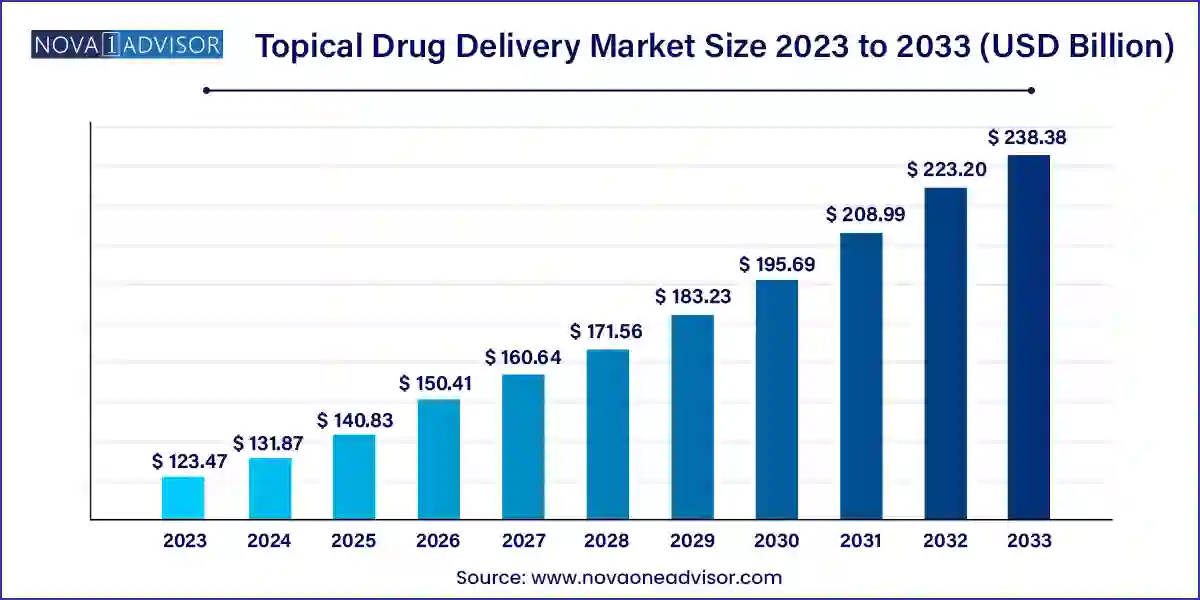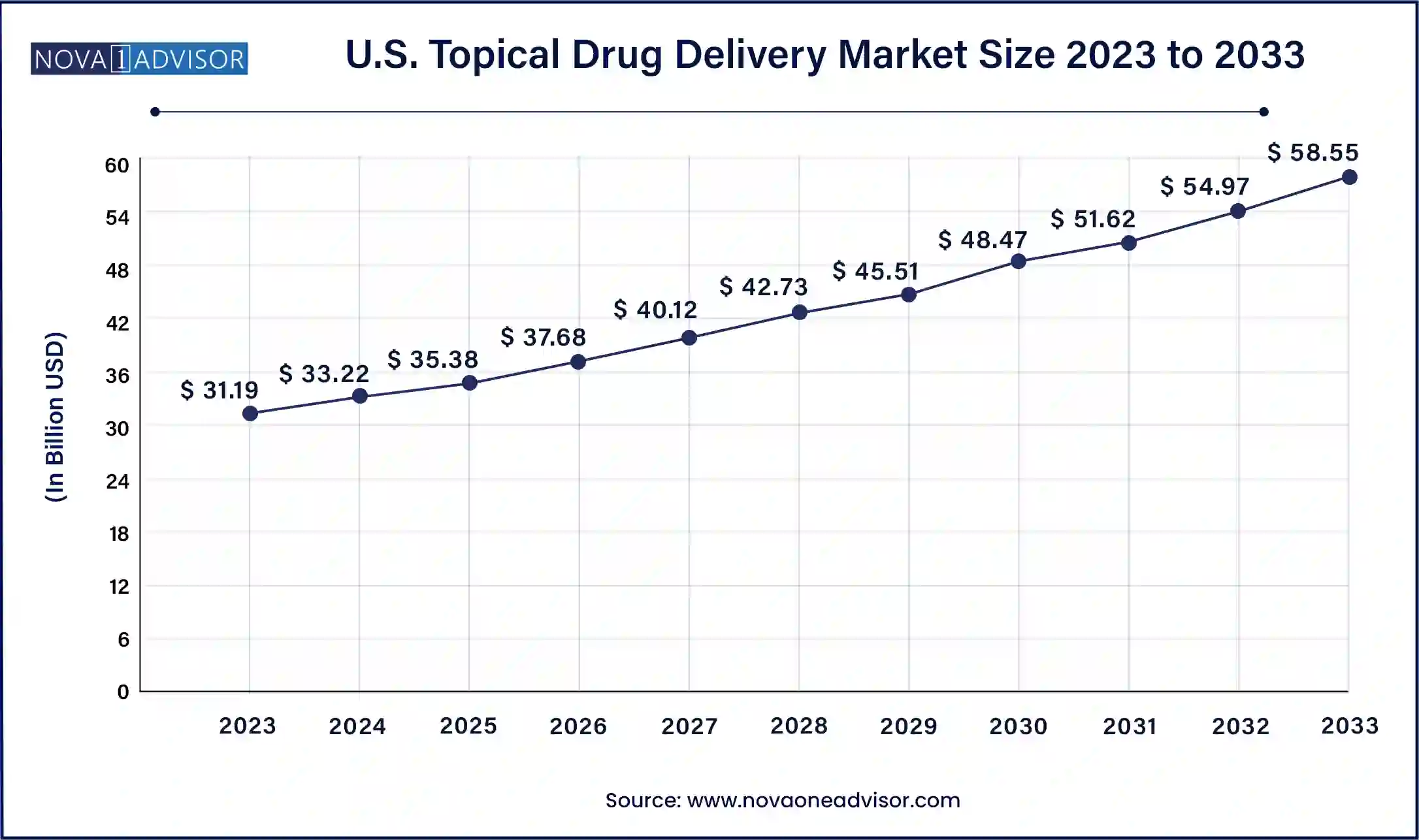Topical Drug Delivery Market Size and Growth
The global topical drug delivery market size was valued at USD 123.47 billion in 2023 and is anticipated to reach around USD 238.38 billion by 2033, growing at a CAGR of 6.8% from 2024 to 2033.

Topical Drug Delivery Market Overview
The topical drug delivery market is a critical segment within the pharmaceutical industry, characterized by the administration of medications through the skin or mucous membranes. This method offers numerous advantages, including localized treatment, reduced systemic side effects, and improved patient compliance. The market's growth is driven by several factors: technological advancements in formulation techniques that enhance drug permeation and bioavailability; rising prevalence of skin disorders, chronic diseases, and conditions requiring localized treatment; increasing consumer preference for non-invasive drug delivery methods; and expanding applications in dermatology, pain management, and cosmetic treatments. Key players in the market are investing heavily in research and development to introduce innovative formulations and improve therapeutic outcomes. Regulatory support and initiatives to streamline approval processes further bolster market expansion. As a result, the topical drug delivery market is poised for continued growth, driven by advancements in science, evolving patient needs, and expanding therapeutic applications.
Topical Drug Delivery Market Growth
The topical drug delivery market is experiencing significant growth driven by several key factors. Firstly, advancements in formulation technologies have enabled the development of more effective topical treatments with enhanced drug absorption and sustained release capabilities. This has expanded the range of conditions that can be effectively treated through topical applications, including dermatological disorders, pain management, and wound care. Secondly, the increasing prevalence of chronic diseases such as arthritis and diabetes has boosted the demand for localized and targeted therapies that minimize systemic side effects. Additionally, growing consumer preference for non-invasive drug delivery methods, coupled with the convenience and ease of use offered by topical formulations, has further fueled market expansion. Moreover, favorable regulatory initiatives and investments in research and development by pharmaceutical companies are expected to drive innovation and market growth in the coming years.
Topical Drug Delivery Market Report Scope
| Report Attribute | Details |
| Market Size in 2024 | USD 131.87 Billion |
| Market Size by 2033 | USD 238.38 Billion |
| Growth Rate From 2024 to 2033 | CAGR of 6.8% |
| Base Year | 2023 |
| Forecast Period | 2024 to 2033 |
| Segments Covered | By Product, Route of Administration, Application, By End User, Region |
| Market Analysis (Terms Used) | Value (US$ Million/Billion) or (Volume/Units) |
| Report Coverage | Revenue forecast, company ranking, competitive landscape, growth factors, and trends |
| Key Companies Profiled | Johnson & Johnson, Novartis International AG, F. Hoffmann-La Roche AG, Pfizer Inc., Bayer AG, Antares Pharma, Inc., GlaxoSmithKline plc, 3M (US), Merck & Co., Inc., Sanofi, Amgen, Inc. |
U.S. Topical Drug Delivery Market Size, Share & Growth Analysis Report 2033
The U.S. topical drug delivery market size was valued at USD 31.19 billion in 2023 and is projected to surpass around USD 58.55 billion by 2033, registering a CAGR of 6.5% over the forecast period of 2024 to 2033.

Geographically, the largest topical drug delivery market share was held by North America, primarily because of the presence of large number of pharmaceutical companies. The Asia-Pacific (APAC) region is anticipated to grow at the fastest pace in the coming times. The reasons for this are the rising healthcare expenditure, adding focus of pharmaceutical companies in the market in developing countries, growing senior population, and surging disposable income.
Topical Drug Delivery Market Dynamics
Driver: High Incidence of burn injuries
The treatment of burn injuries is one of the major application areas of topical drugs. Topical antimicrobial agents such as Fenistil (GSK), Sulfamylon cream (Mylan), Bactroban (GSK), and Silvadene (Pfizer) are considered the first line of treatment for burn injuries in patients.
According to the Lancet Public Health, in 2021, burns were one of the major causes of disability, with more than 8 million disability-adjusted life-years (DALYs). The high incidence of burn injuries in major regional segments across the globe has resulted in sustained demand for topical drugs for effective burn treatment and management. Many topical antimicrobial agents are used to cure burns. An antimicrobial agent such as silver sulfadiazine cream is used to treat wound infections in second and third-degree burns patients. However, patients with severe burns or burns over a large area are treated in a hospital. There are many other antibiotic ointments for burns, such as over-the-counter options for an uncomplicated burn.
Restraint: Continuous irritation on skin and allergies caused by topical drugs
Many topical formulations are available over the counter and include antibacterial & antifungal preparations, anti-inflammatory & pain-relief preparations, and cleansing & moisturizing agents. Topical corticosteroids are used in many inflammatory rashes. However, in some cases, topical corticosteroid sensitivity produces allergic reactions. Usually, this is seen as a failure to cure dermatitis or to worsen existing dermatitis treated with corticosteroids. Very rarely, corticosteroid allergy may appear as an eczematous rash in a completely different area of the body from the original dermatitis. Some topical antibiotics may also cause contact allergies, such as bacitracin, which is used to prevent minor skin injuries such as cuts, scrapes, and burns. Benzocaine and salicylate are some of the active ingredients in topical formulations which causes allergies. These allergies caused by such drugs can be diagnosed by a patch test that can detect contact allergens. Allergy to topical medications is more common in older patients, but some patients with pre-existing skin conditions are at a higher risk of developing allergic reactions to topical medications. These allergies caused by the topical drugs are one of the limitations of the usage of such medicines. In most cases, patients adopt another type of drug delivery system or go for other forms of medicine.
Opportunity: Rising demand for self-administration and home care
Self-administration of drugs within home care settings is expected to provide significant growth opportunities for players operating in the market. This is mainly due to the rising geriatric population and closing regular OPDs for a few months during COVID-19. Elderly individuals form a large consumer base for topical drugs in-home care. This factor also increases the need for inhalation, topical, and transdermal drug products designed to cater to the needs of caregivers and patients. Transdermal drug delivery enhances the ease of administration of drugs as it uses a transdermal patch that can be easily self-administered. It provides suitable and painless self-administration for patients. This approach helps reduce healthcare costs by reducing the duration of hospital stays. Also, in the case of transdermal patches, caregivers can easily determine if a patch is placed securely. This acts as one of the main opportunities to increase the demand for transdermal patches, boosting the growth of topical drug deliveries.
Challenge: Topical formulation for drugs with limited plasma concentration
Topical drug delivery refers to the application of medication to the surface of the skin or within the layers of skin or mucous membrane. Skin acts as a barrier and prevents the penetration of many APIs, even though it is an ideal site to achieve both local and systemic effects via the delivery of drug substances. However, drugs that have a larger particle size are not easily absorbed through the skin. To facilitate skin absorption, the molecular weight of a compound should be under 500 Dalton when developing drug substances for use in topical dermatological therapies. These high molecular weight drugs are poorly lipid-soluble and cannot achieve the desired therapeutic effect and action. Percutaneous absorption decreases with high molecular weight. This decreased therapeutic effect of topical medicines limits the adoption of topical drug delivery.
Product Insights
The semi-solid formulation segment dominated the topical drug delivery market in 2023. Semi-solid formulations are important in the topical drug delivery market. Among these compositions are lotions, ointments, gels, and creams. Their versatility in treating a range of dermatological problems, ease of administration, and capacity to transfer active substances straight to the skin make them attractive. its effectiveness in localized treatment, patient compliance, and non-invasiveness are the main aspects that have contributed to its popularity. Their notable presence in dermatology and other therapeutic fields is largely due to advancements in formulation technology, which continue to improve their stability, bioavailability, and therapeutic efficacy.
The solid formulation segment is expected to be a fastest growing during the forecast period. Solid formulations are essential in the topical drug delivery market because of their application simplicity, stability, and convenience. Creams, ointments, gels, powders, and solid sticks (like lip balms) are some examples of these formulations. Because they can administer medications directly to the skin, where they can act locally or be absorbed systemically, they are favored. Solid formulations are useful for a variety of therapeutic applications in dermatology, pain treatment, and other fields because they preserve drug potency, lower the danger of contamination, and provide regulated release patterns.
Route of Administration Insights
The dermal segment dominated the topical drug delivery market in 2023. The application of pharmaceuticals or remedies directly into the skin is referred to as the dermal mode of administration in the topical drug delivery market. This technique enables the transdermal administration of drugs into the bloodstream for systemic effects as well as the localized treatment of skin diseases like dermatitis, psoriasis, and eczema. Creams, gels, ointments, patches, and sprays are examples of dermal formulations; all are intended to maximize medication absorption through the skin while reducing systemic side effects. This section is influenced by a number of factors, such as skin penetration enhancers, formulation technology, and the particular therapeutic goals of the medicine being administered.
Distribution Channel Insights
The retail pharmacies segment dominated the topical drug delivery market in 2023. In the topical drug delivery market, the retail pharmacies segment is essential for providing customers with direct access to topical pharmaceuticals. A large selection of topical formulations, such as creams, ointments, gels, lotions, and patches, are easily accessible at these pharmacies. Retail pharmacists can offer helpful advice and information on topical medicine use, ensuring correct administration and adherence to treatment plans. It's a convenient one-stop shop for all healthcare needs because patients may pick up their prescriptions together with other health-related products. A prescription is sometimes needed for many topical treatments, and retail pharmacies make it easier and faster to complete these prescriptions.
Online pharmacies are expected to be a fastest growing market. For a number of reasons, the topical drug delivery market's online pharmacies segment is growing in importance. Accessible and convenient, a large assortment of topical drugs and formulations are offered by online pharmacies. They provide competitive pricing and discounts to meet the growing demand for digital health services from consumers. Additionally, internet pharmacies frequently offer thorough product details and client testimonials, which boosts consumer confidence when buying topical medication delivery items online. This market is predicted to keep expanding as digital health services become more widely available worldwide.
Key Market Developments
Topical Drug Delivery Market Top Key Companies:
Topical Drug Delivery Market Report Segmentation
This report forecasts revenue growth at country levels and provides an analysis of the latest industry trends in each of the sub-segments from 2021 to 2033. For this study, Nova one advisor, Inc. has segmented the Topical Drug Delivery market.
By Product
By Route of Administration
Distribution Channel
By End User
By Region